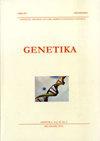Identification and examination of certain cytogenetic characteristics of some autochthonous varieties of grapevine in Republic of North Macedonia
4区 农林科学
Q3 Agricultural and Biological Sciences
引用次数: 0
Abstract
In R.N. Macedonia has a large number of autochthonous or domestic varieties (cultivars) of grapevine that are grown as individual vines or in small, limited plantations. Until the beginning of the 20th century and before the phylloxera attack in our country, native varieties were much more represented. Autochthonous varieties existed and were cultivated for a long time in several vineyards and were characterized by stable and significant properties. These varieties are adapted to the environmental conditions where they are grown and are carriers of stable genes that can be used in further selection and hybridization to obtain new grape varieties. Therefore, it is very important for a country (region) to have autochthonous varieties in its assortment.In this paper, we considered four autochthonous grape varieties - two table varieties (Konchanka and white winter) and two wine varieties (Ohrid white, Ohrid black). We tried, according to the ampelographic description and certain characteristics of the reproductive system, to determine their origin. According to the phenotypic characteristics that refer to the centers of origin of the varieties, the studied varieties - Konchanka and White winter belong to the Eastern varieties convarietas orientalis, subconvarietas antasiatica, and the studied varieties Ohrid white and Ohrid black variety belong to the Black Sea - Balkan varieties convarietas. pontica, subconvarietas balcanica. Among the examined varieties, the properties from the second group of descriptors are described in detail according to the proposals of O.I.V. According to some codes (characteristics) there is a big difference between varieties. Also, for a more detailed differentiation of the varieties, cytological properties were examined - pollen germination and vitality, number of chromosomes in mitosis and meiosis, ploidy level, percentage of fertilization (fecundation), self-fertilization (autogamy) and cross-fertilization (xenogamy). The statistical processing of the ampelography data is according to a cluster program (SPSS) that works on the binary similarity or dissimilarity as measures used to group the data and further form a clear dendogram display.北马其顿共和国一些葡萄乡土品种细胞遗传学特征的鉴定和检验
马其顿有大量的本地或国内葡萄品种(栽培品种),这些葡萄作为单独的葡萄藤或在小的,有限的种植园中种植。直到20世纪初,在根瘤蚜袭击我国之前,本土品种的代表性要大得多。本地品种已经在几个葡萄园种植了很长时间,具有稳定和显著的特性。这些品种适应了它们生长的环境条件,并且是稳定基因的载体,可以用于进一步的选择和杂交以获得新的葡萄品种。因此,一个国家(地区)在其分类中拥有本土品种是非常重要的。在本文中,我们考虑了四个本土葡萄品种-两个食用品种(Konchanka和冬季白)和两个葡萄酒品种(Ohrid白,Ohrid黑)。我们试图根据脉象图的描述和生殖系统的某些特征来确定它们的起源。根据品种起源中心的表型特征,所研究的品种“Konchanka”和“White winter”属于东方品种“convarietas orientalis”和“antasiatica”亚品种,所研究的品种“Ohrid White”和“Ohrid black”属于黑海-巴尔干品种“convarietas”。庞蒂卡,巴尔干次变种。在被审查的品种中,第二组描述符的性质根据o.i.i.的建议进行了详细的描述。在某些编码(特征)上,品种之间存在较大的差异。此外,为了更详细地区分品种,细胞学特性进行了检查-花粉萌发和活力,有丝分裂和减数分裂的染色体数,倍性水平,受精百分比(受精),自受精(自交)和异交受精(异种交配)。地形图数据的统计处理是根据一个聚类程序(SPSS),该程序对二元相似性或不相似性进行处理,作为对数据进行分组并进一步形成清晰的树状图显示的措施。
本文章由计算机程序翻译,如有差异,请以英文原文为准。
求助全文
约1分钟内获得全文
求助全文
来源期刊

Genetika-Belgrade
AGRONOMY-GENETICS & HEREDITY
CiteScore
1.80
自引率
0.00%
发文量
1
审稿时长
6-12 weeks
期刊介绍:
The GENETIKA is dedicated to genetic studies of all organisms including genetics of microorganisms, plant genetics, animal genetics, human genetics, molecular genetics, genomics, functional genomics, plant and animal breeding, population and evolutionary genetics, mutagenesis and genotoxicology and biotechnology.
 求助内容:
求助内容: 应助结果提醒方式:
应助结果提醒方式:


